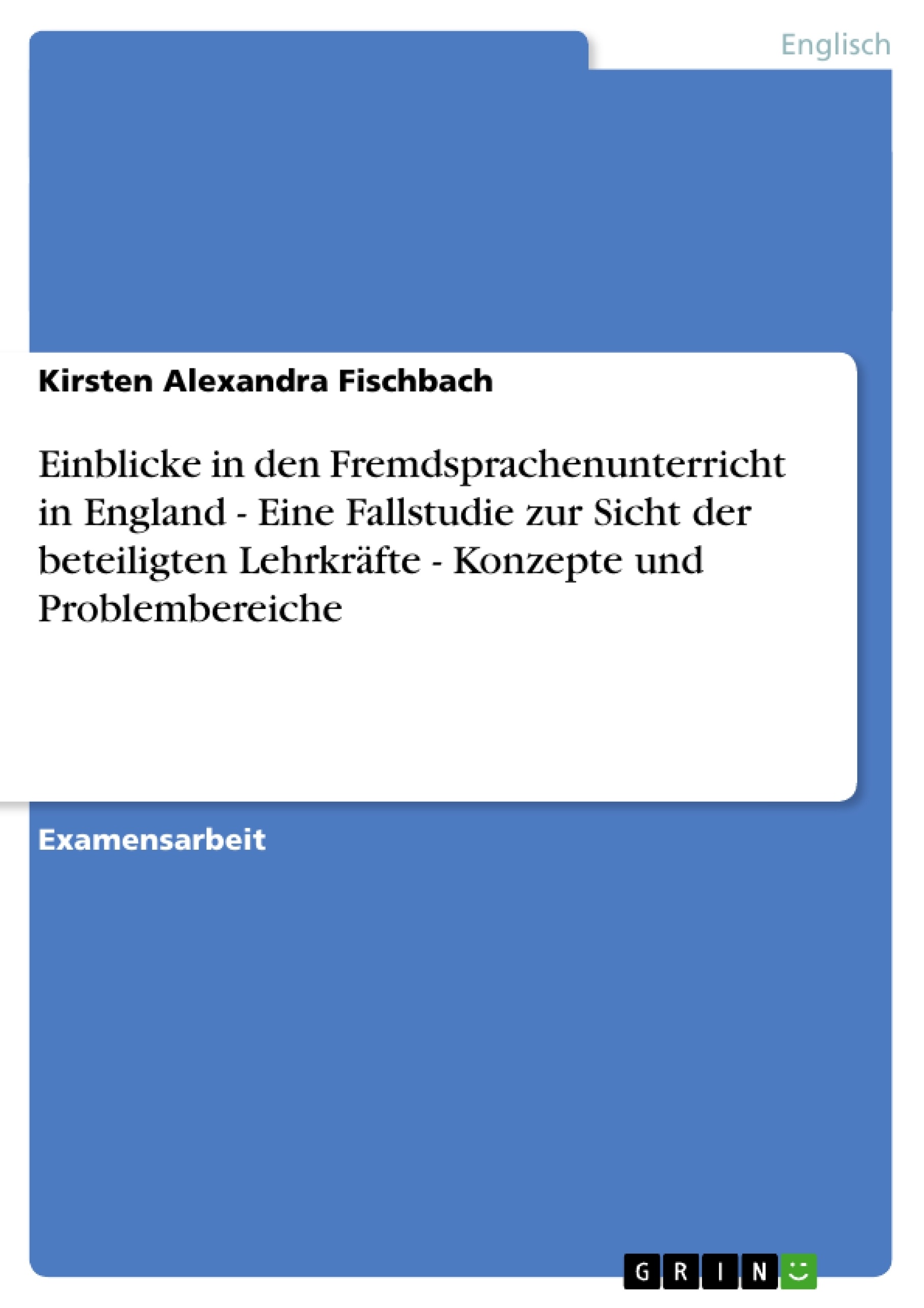In recent decades the teaching of Modern Foreign Languages (MFL) in secondary
schools in the UK has witnessed a number of important developments. Concepts
have gone in and out of fashion and there have been considerable innovations in the
field of educational technologies.
The case study carried out in the John Taylor High School (JTHS) in Staffordshire
affords insights into the MFL teaching in England and is based on the teachers’ point
of view. Because of the current MFL teaching methodology, which is characterised
by an emphasis on communicative competence, all the teaching concepts in JTHS
ultimately aim to develop independent communication by their students. The so
called Communicative Language Teaching (CLT) is used as a methodological
framework in this essay, which encompasses a number of different teaching
concepts. Every concept discussed in the essay is selected with the help of the
questionnaires and survey sheets distributed amongst teachers and students. The
essay has a few theoretical explanations which are based on the statutory framework
governing MFL teaching in England and also the JTHS department´s aims and
objectives.
The main conclusions of this research are:
The MFL teachers in JTHS are convinced that each individual teaching approach
will be right for some learning situations. They tend to use a varying range of
teaching approaches in order to prepare their students for autonomous learning. For
teachers in the MFL department it is very important to recognise that pupils are
individuals with different needs – for instance, due to their ability, gender, interests,
motivation, self- concept and self-esteem – and that, therefore, no teaching group is
homogenous. It must be remembered that all MFL teaching groups are different.
Each has its own range and mix of pupils needs. For this reason the teachers use
individual and varied styles of working.
The way in which the entire NC is organised will effect how MFL is taught. A major
task for the MFL department is to translate National Curriculum (NC) programmes
of study into schemes of work, which are then differentiated for the range of pupil
abilities. A wide range of resources should help them to choose the most effective ways to maximise the progress of all learners. The growing emphasis on
communication as the prime purpose of MFL has placed grammar in a secondary
position. Grammar can be taught and learnt in a formal and an informal. [...]
Inhaltsverzeichnis
- 1. Einleitung
- 2. Die John Taylor High School in Staffordshire, England
- 2.1 Darstellung der Schule
- 2.2 Fachbereich Modern Foreign Languages (MFL)
- 3. Durchführung einer Fallstudie im Fachbereich MFL
- 3.1 Vorbereitungsphase
- 3.1.1 Pretest
- 3.1.2 Fragebogen für MFL-Lehrkräfte
- 3.1.3 Umfragebogen für Schüler von year 7 bis year 13
- 3.2 Feldphase
- 3.3 Bezugsrahmen zum Fremdsprachenunterricht – eine Übersicht
- 3.3.1 Das NC für key stage 3 und 4
- 3.3.2 Schemes of work
- 3.3.3 Subject criteria für die sixth form
- 3.1 Vorbereitungsphase
Zielsetzung und Themenschwerpunkte
Diese Hausarbeit befasst sich mit dem Fremdsprachenunterricht in England, speziell mit der Sichtweise der beteiligten Lehrkräfte. Die Fallstudie analysiert die Lehrmethoden und Konzepte in der John Taylor High School (JTHS) in Staffordshire und untersucht, wie diese den aktuellen Anforderungen des National Curriculum (NC) entsprechen. Besonderes Augenmerk liegt auf der Umsetzung der Communicative Language Teaching (CLT)-Methodik und der Integration von kulturellen Aspekten in den Unterricht.
- Die Herausforderungen und Chancen des Fremdsprachenunterrichts in England
- Die Rolle des National Curriculum (NC) im Fremdsprachenunterricht
- Die Anwendung der Communicative Language Teaching (CLT)-Methodik in der Praxis
- Die Bedeutung von kultureller Kompetenz im Fremdsprachenunterricht
- Die Bedeutung von authentischen Materialien und Medien im Fremdsprachenunterricht
Zusammenfassung der Kapitel
Die Arbeit beginnt mit einer Einführung in das Thema und beschreibt die John Taylor High School und den Fachbereich Modern Foreign Languages (MFL). Kapitel 3 erläutert die Durchführung der Fallstudie, einschließlich der Vorbereitungsphase mit Pretests und Fragebögen für Lehrkräfte und Schüler sowie der Feldphase. Es werden relevante Bezugsrahmen zum Fremdsprachenunterricht wie das NC für key stage 3 und 4, Schemes of work und Subject criteria für die sixth form vorgestellt. Die Arbeit geht auf die Rolle von Lehrkräften im Fremdsprachenunterricht, die Nutzung verschiedener Lehrkonzepte, den Einfluss des National Curriculum und die Bedeutung von kulturellem Verständnis ein.
Schlüsselwörter
Fremdsprachenunterricht, England, John Taylor High School, Communicative Language Teaching (CLT), National Curriculum (NC), kulturelle Kompetenz, authentische Materialien, Medien, Foreign Language Assistant (FLA)
- Quote paper
- Kirsten Alexandra Fischbach (Author), 2002, Einblicke in den Fremdsprachenunterricht in England - Eine Fallstudie zur Sicht der beteiligten Lehrkräfte - Konzepte und Problembereiche, Munich, GRIN Verlag, https://www.grin.com/document/16925



